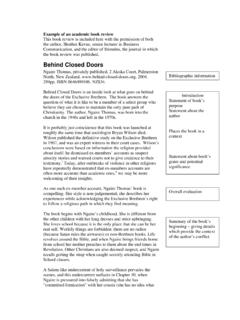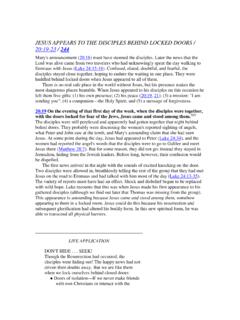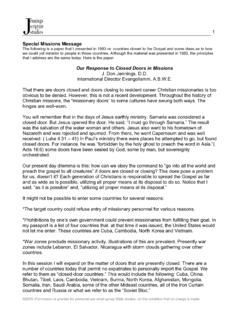Transcription of Behind Closed Doors - The Pragmatic Programmer
1 Extracted from: Behind Closed DoorsSecrets of Great ManagementThis PDF file contains pages extracted from Behind Closed Doors , published by thePragmatic Bookshelf. For more information or to purchase a paperback or PDFcopy, please :This extract contains colored text. This is available only in online versions ofthe books. The printed versions are black and white. Pagination might varybetween the online and printer versions; the content is otherwise 2005 Johanna Rothman and Esther rights part of this publication may be reproduced, stored in a retrieval system, or transmitted, in any form, or byany means, electronic, mechanical, photocopying, recording, or otherwise, without the prior consent of of us have seen bad management at work, and you mightlearn whatnotto do by watching bad management.
2 But to be agreat manager, avoiding what not to do isn t good enough greatmanagers actively learn the craft of s worth learning how to be a great manager both in humanand in economic costs. The costs of bad management are enor-mous; we ve been in numerous situations where we ve seen thecompany fold because the managers couldn t manage their managers amplify the work of others, the human costsof bad management can be even higher than the economic ve seen people who were invaluable to the organization leavebecause they refused to work with poor managers managers whodepressed morale and productivity. We ve talked to people whodescribe treatment that borders on abuse, meted out as manage-ment.
3 Learning to be a great manager by yourself isn t easy even ifyoucarefully observe great managers. One of the reasons good man-agement is so hard to learn is that much of management takesplace Behind Closed Doors . Generally speaking, you can observeonly the public behaviors of managers and how your managersinteract with managers interact with people of all personalities, skill levels,and motivations. And since those interactions often take place inprivate one-on-one meetings and in conference rooms where man-agers work together, the work is invisible to the rest of the worldand to people aspiring to re going to open those Doors and allow you to see great man-agement in of preaching rules of management and innundating youwith bullet points and checklists, we re going to open thosecloseddoors and show you firsthand how a great manager handles thenormal, day-to-day challenges and crises that arise.
4 Our greatmanager is we begin our story, Sam Morgan has just taken the new positionof Director of Development in a high-tech organization. Samis inhis midforties and has been managing groups of technical peoplefor more than ten years. He s pretty sure everyone wants to doa good job, but it seems they don t always know what to do orhow to do it. His job is to make sure everyone in his department including the managers knows what they need to do and that theyhave the right tools to do their jobs. Four managers report O Brien is in her late twenties. This is her first managementjob, heading up the User Interface (UI) department. She is ambi-tious, excited about her work, and sure that there s one right wayto do anything even if she doesn t know that way McCloud manages the Middleware department.
5 He s in hisearly thirties. He s tired. He slogs through the days, trying to keepup with all the work. He s sure if he just works hard enough, he Stone manages the Backend group but has extra responsi-bilities toward the Operations group. He has been managing peopleand projects for five years. He feels responsible for the Operationspeople, because they were part of his group until just a few , Patty Larsen manages the Database group. She s filling inas an acting manager as a favor to the previous director. She s inher midtwenties, and she s frustrated with being a to return to working as a technical ll follow Sam over the course of his first weeks on the job. Watchas Sam works with his managers to create an effective and produc-tive department, despite the usual array of do you think Sam will do first?
6 CL I C KHE REto purchase this book about the People andthe WorkSome people think management is all about the people, and somepeople think management is all about the tasks. But great manage-ment is about leading and developing people and managing you want to lead people, you need to know them: their uniquestrengths, aspirations, and patterns of behavior. If you want tomanage work, you need to see what people are doing and under-stand how it fits into the context of the group s need to learn three things when you enter a new organizationor job: Who the people are their strengths and interests and whatthey are working on The stated mission of the group and how the group providesvalue How your group fits into the larger organizationIt would be great to learn this informations on your first day andin nice neat boxes.
7 But it doesn t work that way; the informationwill emerge and coalesce as you uncover information and performmanagement work. Start with the people first in order to buildtrust and lay the foundation for a cohesive team. A good way todothis is to meet one-on-one with everyone who reports to MorningGinger, the UI manager, arrived for her first one-on-one withSam,breathless and three minutes late. Come on in and sit down, Ginger, Sam said. What s this meeting for? Our old manager never did this, Gingersaid, as she flipped her red ponytail over her shoulder and plunkedherself down in the chair. Crossing her arms, she leaned back. I like to meet with my direct reports every week.
8 Oh. What do you want me to say? Ginger asked. For this week, I d like to get to know you better. Tell me a littleabout yourself. Sam opened his notebook and looked at Ginger,calm and led the conversation to learn how Ginger worked and feltabout her job. He used open-ended questions such as How didyou come to be in this job? What do you enjoy about your job? and What aspects are frustrating? to tease out the Ginger declared she didn t have enough people to keep upwith Marketing s ever-changing demands, Sam decided to probefor more information. Tell me more about the ever-changing Marketing demands youmentioned. What s going on with that? As Sam asked more questions, he began to develop an understand-ing of how Ginger was working with the Marketing group and howshe wasn Sam felt he had heard enough to grasp the situation, heswitched to a topic he always covered when he started with a newgroup.
9 Are there any personnel or pay issues for you or anyone in yourgroup? Ginger shrugged. No, I m happy, and as far as I know, my staffishappy too. Sam and Ginger spent the rest of their half hour together talkingabout the projects Ginger s group was working I C KHE REto purchase this book AT ATIME10As he brought the meeting to a close, Sam asked, Is there anythingI missed? Ginger shook her head. Okay, how does this time workfor you to set up a regular weekly one-on-one meeting? You mean we re going to meet every week? Yup. Every week, said Sam. Okay, this is as good as any day, Ginger acquiesced. Thanks for taking time to meet with me. If you think of anythingelse that I should know, or you have any question for me or aboutme, drop by.
10 By the end of the day, Sam had met with all four managers. Helearned that Ginger, the UI manager, had hair that matched hername and her temperament. Kevin, the Middleware manager, wasa nice fellow very technical but Sam wasn t sure how Kevin orga-nized and prioritized the work for his group. Jason, the Backendmanager, had his hands full with the Backend group supportingOperations as well as coaching his son s hockey , the Database manager, was hard to read. She d answeredquestions but hadn t volunteered had seen a common theme emerge: everyone claimed he orshe had too much to do and needed more One Person at a TimeProperly done, one-on-ones build relationships. Managerswho useone-on-one meetings consistently find them one of the most effec-tive and productive uses of their management time.










